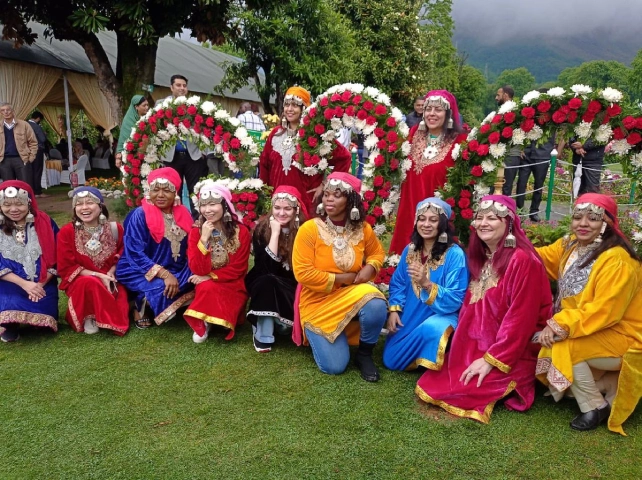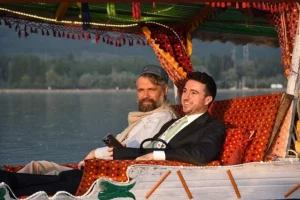Srinagar: Notwithstanding a well-oiled diplomatic and propaganda campaign by Pakistan, terror threats and a warning from Foreign Minister Bilawal Bhutto Zardari, the G20 event in Kashmir—the third meeting of the Working Group on Tourism—turned out to be a big success for India.
Monday through Wednesday, there was no curfew, no hartal, no internet shutdown, no shuttered businesses or schools and no restriction on movement of pedestrians or vehicles. Just a part of the boulevard, leading to the main venue of the conference, the Sher-e-Kashmir International Convention Centre (SKICC), remained closed for two days for security reasons.
Some schools in town, whose bus fleets cause traffic jams every day, were also closed. These included a private school of 5,000 students in the garrison area which witnessed a fierce encounter in June 2017.
There was no IED blast, no grenade attack, no shooting from guns either. Also, in contrast to many occasions in the past, no protest, no demonstration, no slogans, no stone pelting, no memorandum to the UNMOGIP headquarters at Sonwar.
The conference, which was attended by official delegations from 17 of the 20 G20 nations— China stayed away while Saudi Arabia and Turkey sent private business representatives—was held in the face of a myriad of uncertainties. Never before was an international conclave held in Jammu and Kashmir.
Pakistan foreign minister Zardari implored the world leaders to stay away from the conference as it, he argued, was being held in a “disputed territory”. They referred to the UNSC resolutions of 1948-49, seeking a resolution to the Kashmir problem through ‘plebiscite’. Zardari went to the extent of threatening that if India went ahead with the conference in Srinagar, Pakistan would come up with a response which “will be remembered for a long time.”
Now that the three-day rendezvous has ended peacefully, with near-total attendance and without a single incident of violence or protest, it is being widely seen as India’s remarkable diplomatic achievement over Kashmir.
Kashmir built its first ‘International Convention Centre’ when Sheikh Mohammad Abdullah was Chief Minister in 1978-80. But an international conference was never held there. Just two-odd international events were organised 37-40 years back: first, a cricket match between India and West Indies in 1983, and the second, a cricket match between India and Australia in 1986.
Pakistan, with the support of the US was responsible for making the valley barren as they trumpeted that Jammu and Kashmir was “disputed” and pending for a resolution as per the UN resolutions. This rant went on even after Zulfikar Ali Bhutto and Indira Gandhi converted the ‘ceasefire line’ into the ‘Line of Control’ and agreed at Shimla in 1972 to resolve all issues through bilateral talks. Bilawal’s mother and Zulfikar’s daughter, Benazir, then 19-year-old, was also present.
Bilawal is born with an inheritance of rhetoric. His grandfather tore papers in rage at the UNSC. He threatened a “1000-year-long war” with India. Soon his country was halved in a rebellion. In 1990, his mother at Muzaffarabad shouted at a rally that “every child of Kashmir” would fight India and chant “azaadi, azaadi, azaadi”. Three decades later, her successor Prime Minister Imran Khan is calling for Pakistan’s “azaadi” from the Army and America.
For decades, nonetheless, Pakistan opposed India’s plans for international events in Kashmir. Twenty years ago, it succeeded in blocking a Rs 1,000 crore World Bank fund for Integrated Watershed Development Project (IWDP Hills-II) in Jammu and Kashmir. It objected to and campaigned against all visits of world leaders who didn’t have the agenda of forcing India to reconcile to Islamabad’s terms of negotiations.
The high-profile UN diplomatic visits to Kashmir ended in the first 3-4 years after 1947. In 1955, Kashmir was in international news when the Soviet Union Prime Minister Nikolai Bulganin visited Srinagar with the First Secretary of the Communist Party of the Soviet Union, Nikita Sergeyyevich Khurshchev.
Years later in 1984, the Imam of Kaba Sheikh Abdullah Bin Sabil’s visit to Kashmir hogged headlines. It was, however, purely religious and there was nothing political in his engagements.
Later, after the insurgency broke out, British Parliamentarian Gerald Bernard Kaufman visited Kashmir. It triggered a series of visits by foreign envoys for the next two decades. They frequently visited the separatists and former militant commanders. On one occasion, the European Union delegation in Srinagar described Kashmir as the “world’s largest open-air jail”.
However, after the Lok Sabha and Assembly elections of 2014, the foreign envoys turned their back on the Hurriyat and other separatists. They stopped visiting, meeting and inviting them to their New Delhi missions and foreign countries.
When Jammu and Kashmir’s special status was revoked in Parliament in August 2019, Pakistan mounted a concerted diplomatic campaign, impressing upon the entire world to intervene and force New Delhi to restore the status quo ante. With some help from China, Pakistan raised the issue at the UN but failed to garner any support other than a rhetorical service from Turkey.
Even as Pakistan succeeded to sponsor a big campaign in the international media, three sizable diplomatic troupes visited Kashmir for an assessment of the situation in 2019-2022. They found the ground realities far different from what Pakistan projected in world forums.
With empirical data and statistics, the Indian authorities established that Kashmir’s turbulence was nothing but a result of “Pakistan-sponsored jihadist terrorism” and the political space Islamabad had grabbed within the State through the separatists and some pliable mainstream politicians.
The Indian authorities established before the world diplomats that the entire street violence, clashes with police and security forces and hartal calendars had deflated immediately after New Delhi pulled the rug. They underscored how hundreds of civilians, police and security forces personnel had got either killed or injured in the four years before August 2019 and how guns, grenades, tear smoke and pellet guns had fallen completely silent after abrogation of Article 370.
Now that New Delhi’s “test dose” has gone as per its calculations and the setback to Bilawal will be remembered for a long time, one should expect not only a manifold increase in the tourist footfall and trade in Kashmir but also more and far bigger international events in Jammu and Kashmir.
Also Read: G20 Kashmir meet focuses on film tourism as Bollywood celebs join discussions















